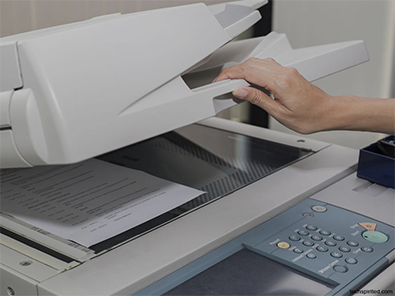Lexmark’s ‘Perceptive’ Strategy Pays Off Well Ahead of Schedule
Lexmark’s decision a little more than a year ago to exit the inkjet printing business wouldn’t look quite as brilliant today if not for the tremendous and immediate performance of its Perceptive Software unit. With more services and software acquisitions under its belt – and surely more on the way – CEO Paul Rooke and company are reminding everyone in this industry that more is often lost by indecision than any one wrong (or risky) decision.
Rather bemoan what we already know – printing has and will continue to decline and hardware sales will, for the most part, follow suit – let’s acknowledge that Lexmark and most of the other top-tier OEMs have and still do make a ton of money from this retracting sector. No matter how dire the outlook, how bleak the landscape, it’s still not easy for any publicly traded company to prematurely walk away from millions of dollars in profits.
Saying that, Lexmark deserves credit for making the best and most forward-thinking decision – some might say the only decision – to abandon a dying, albeit lucrative, cornerstone of their business and identity in favor of new businesses based on services and managed digital content. It’s the same conclusion that all the other major OEMs – some faster and more significantly than others – have come to as they awkwardly (and slowly) kiss the traditional printing model goodbye before sneaking off to Silicon Valley to sync up with their digital mistresses.
So far, so good. But it didn’t come easy. Laying off about 13 percent of your workforce and eating roughly $160 million in restructuring chargers never is.
However, the Perceptive Software unit it acquired in 2010 recorded sales of $59 million in the third quarter, up 38 percent from the year-ago quarter. Overall, Lexmark’s Imaging Solutions and Services unit checked in with $837 million in the quarter and managed print services sales surged up 18 percent to $184 million. Meanwhile, inkjet sales plummeted 44 percent from the prior year to just $84 million, or less than 10 percent of the company’s total sales in the three-month period.
“Lexmark’s value proposition is unique and squarely focused on helping our customers solve their unstructured information challenges, enabling us to lead in this large and expanding market,” Rooke said in the earnings release.
Amen.
Building the new-look Lexmark byte by byte
Perceptive Software isn’t the only enterprise content and document management software acquisition putting fresh wind behind Lexmark’s sails.
In August, it shelled out $72 million for Saperion AG, an ECM and business process management software with customers including Lufthansa, Vodafone, Daimler and Siemens. In March 2012, it snapped up ISYS Search Software, an Australian company that builds enterprise search solutions, for $32 million and Nolij Corp., a developer of Web-based document imaging and workflow software, for about the same amount.
And earlier this month, it paid $54 million in cash for PACSGEAR, a leading provider of connectivity solutions for hospitals and health care facilities.
Throw in San Francisco-based Twistage, which developed a cloud platform for managing video, audio and image content and Seattle-based AccessVia, which makes software that prints on-demand in stores on printers, MFPs and handheld devices, and you can see where Lexmark thinks it belongs today, tomorrow and long into the future.
“Lexmark is continuing to increase shareholder value through acquisitions and organic investments that are accelerating our transition to a higher value solutions portfolio, and through the ongoing capital return of more than 50 percent of free cash flow,” Rooke added.
Rave reviews from Wall Street
This aggressive, expensive and foreward-thinking strategy manifested in a much-better-than-expected third quarter across the board. Total sales checked in at $890.5 million – well above the $871.7 million consensus estimate – while net income, excluding one-time items and charges, came in at 95 cents a share, besting the Street forecast of 91 cents a share.
But it gets even better.
Lexmark, which had been projecting combined sales growth of about 15 percent for its Perceptive Software and MPS units, now expects those figures to “be a little more as we finish up the fourth quarter,” according to Rooke.
After drastically revising its full-year sales estimates as the unavoidable consequence of turning its back on the inkjet crowd, Lexmark is now raising its 2013 sales and earnings targets entirely on the strength of these new software and services units. Now its full-year sales are expected to only decline by between 5 percent and 6 percent – a slight but certain improvement from the 6 percent to 7 percent it originally forecast.
This double dose of good news pushed Lexmark (NYSE: LXK) shares up 7 percent in the hours immediately following the earnings release on Tuesday. Earlier in the week, Tigress Financial upgraded the stock from a “buy” to a “strong buy” recommendation.
For now, seven of the 11 analysts following Lexmark maintain an “underperform” rating on the stock, while three others have assigned it either a “hold” or “neutral” recommendation.
Zacks Investment Research is one of the firms that reiterated its “neutral” rating on the stock shortly after the third-quarter results and full-year outlook were revealed.
“Though synergies from the recent acquisitions and renewed focus on the software space could set it back on the growth path, their impact on results could still be some way off,” a Zacks analyst wrote in a research note. “Though constant pricing pressure from competitors such as Canon, Xerox and Hewlett-Packard and a high debt burden will be concerns, we expect Lexmark to turn the tables with an increased focus on software and services.”
Expect more of this same “focus” from Lexmark and its OEM brethren throughout 2014.
Posted by Larry Barrett on 10/28/2013


